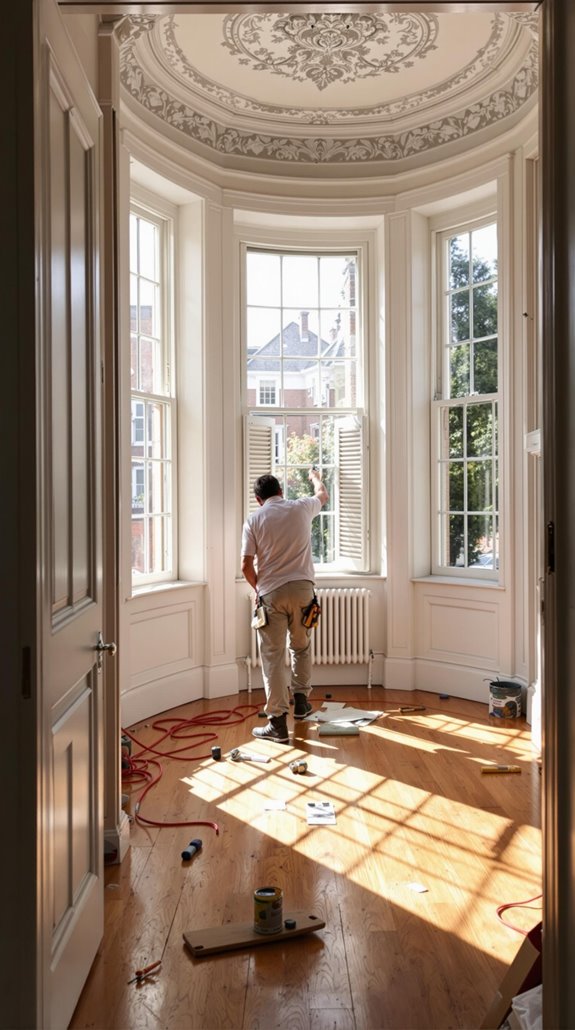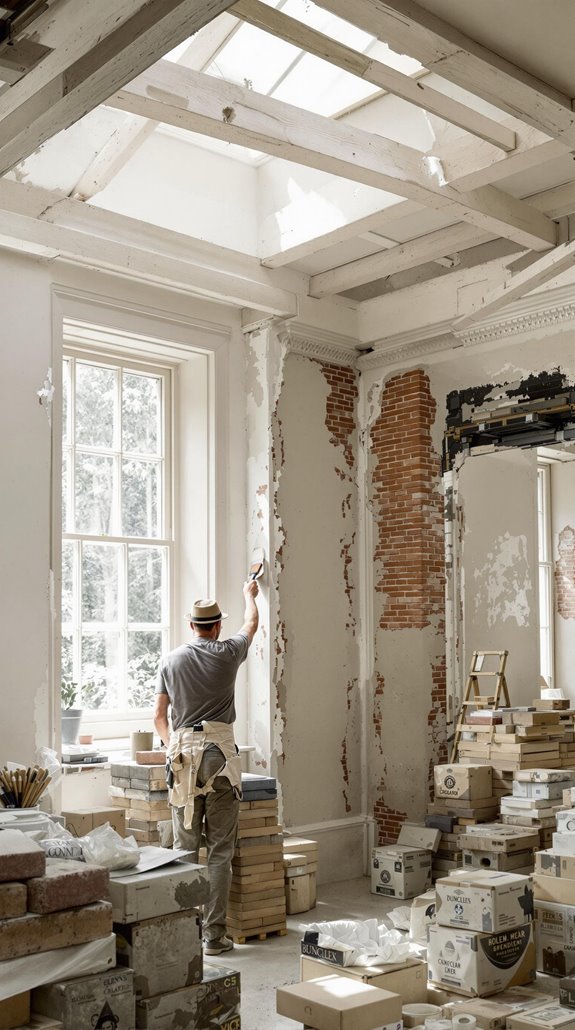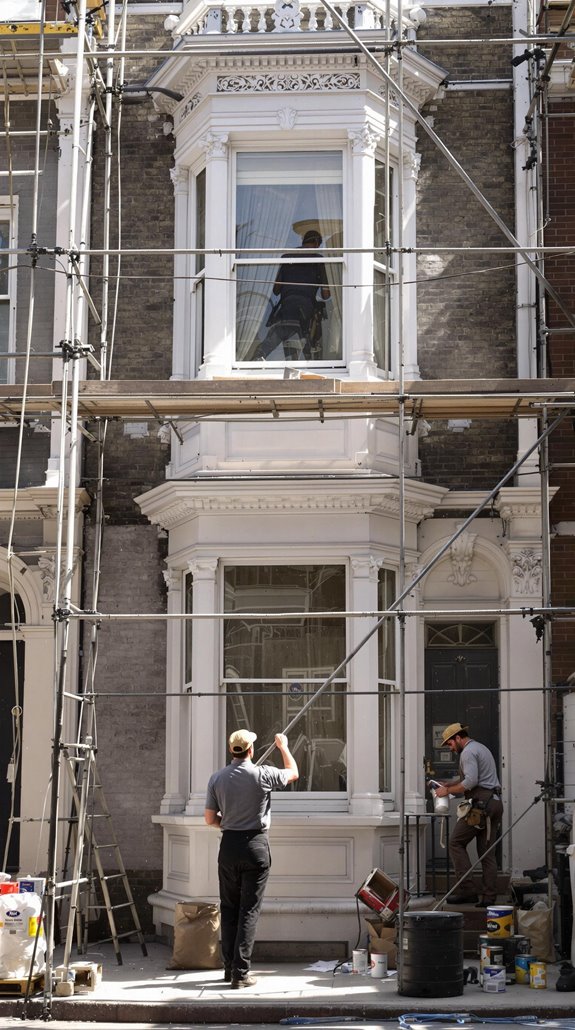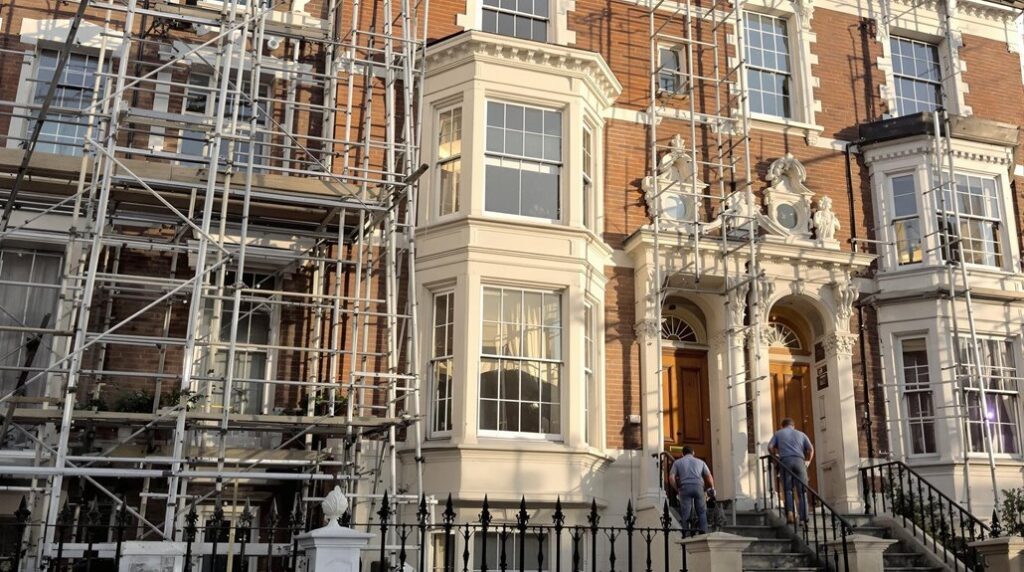I’ll walk you through the essential steps for restoring your Georgian home’s authentic character while meeting modern conservation standards. You’ll need specialized tools like moisture meters, lime mortars, and traditional joinery techniques to preserve original sash windows, crown moldings, and period stonework. The key lies in understanding breathable materials and working with heritage-approved craftsmen who can navigate listed building regulations. But before you contact any specialists, there’s one critical assessment that determines your entire restoration approach.
Key Takeaways
- Contact your local conservation officer early to understand listing restrictions and secure necessary planning permissions before starting work.
- Engage specialist craftsmen like sash window experts, lime plasterers, and stonemasons who understand traditional Georgian restoration techniques.
- Budget 20-40% extra for conservation-compliant materials and 10-15% additional for hidden structural issues like rot or subsidence.
- Preserve original features through mathematical precision in symmetry while concealing modern amenities behind period-style cabinetry.
- Use breathable materials like lime mortar and hair-reinforced lime plaster to manage moisture and maintain structural integrity.
Understanding Georgian Architecture and Its Distinctive Features
Georgian architecture’s mathematical precision demands careful measurement and documentation before you begin any renovation work. I’ll walk you through the key features that define authentic Georgian design, so you can identify what needs preserving versus updating.
Start with your facade’s symmetry—measure window spacing, door placement, and overall proportions. You’ll find classical elements like pilasters, cornices, and pediments that require specialized restoration techniques. Document your sash windows‘ multi-pane configurations and measure how window sizes decrease on upper floors. It’s also essential to be aware of any Conservation Areas that may influence your renovation plans.
Inside, map your room layouts for symmetrical arrangements and enfilade sequences. Use a laser level to check ceiling heights—principal floors should feel grand. Pay special attention to your home’s symmetrical chimneys, as these architectural elements are crucial for maintaining the balanced proportions that define Georgian style. Finally, assess your exterior materials: original brick, stone, or later stucco rendering. These measurements become your renovation blueprint, ensuring you maintain the architectural integrity that makes Georgian homes so distinctive.
Navigating Listed Building Regulations and Planning Requirements
Before you pick up a single tool, contact your local conservation officer to determine your property’s listing grade and specific restrictions. I can’t stress enough how essential this step is – even minor electrical work requires Listed Building Consent.
You’ll need to submit detailed plans showing existing conditions and proposed changes. Document everything with photographs and architectural drawings. The conservation officer will assess each modification individually, considering your Georgian home’s unique historical features. Engaging with listed building specialists can significantly enhance your understanding of the necessary compliance measures.
Don’t risk unauthorized alterations – unlimited fines and prosecution await. I’ve seen homeowners forced to restore original features at enormous cost after making unapproved changes. Retrospective applications for consent can lead to required undoing of unauthorized work.
Research available grants from English Heritage and local authorities. These funding sources can offset restoration expenses considerably. Partner with heritage specialists who understand Georgian construction techniques and regulatory requirements.
Preserving Original Period Features During Renovation

When you’re ready to tackle your Georgian renovation, identifying and cataloging every original feature becomes your first critical task. I’ll walk you through documenting sash windows, crown moldings, and paneled doors with detailed photographs and condition reports. You’ll need conservation specialists to authenticate period details and prioritize urgent repairs. Selecting the right plaster type can significantly enhance the aesthetic of your restored walls.
Focus your restoration efforts on traditional techniques—repair sash windows using hardwood timber and draught-proofing methods, restore woodwork with lime-based paints, and recreate missing plasterwork using historic molds. Avoid common mistakes like replacing original timber windows with PVC or removing built-in features for open-plan layouts.
Your long-term preservation strategy should include regular maintenance schedules, humidity control through proper ventilation, and bi-annual inspections by conservation-accredited contractors to protect your investment. Remember that sympathetic updates can enhance your property’s monetary worth while maintaining the authentic Georgian character that makes these homes so desirable.
Incorporating Modern Amenities While Maintaining Historical Character
Since Georgian houses weren’t built for modern living, you’ll need strategic planning to integrate contemporary amenities without compromising their historical integrity. I’ve found that concealing modern appliances behind period-style cabinetry works brilliantly—your dishwasher and microwave disappear when not in use. For heating upgrades, install underfloor systems beneath restored original floors rather than bulky radiators that disrupt wall proportions. When updating electrical systems, run new wiring through existing service routes to avoid damaging historical fabric. Breakthrough fire safety technologies now allow discreet smoke detection systems that blend seamlessly with period ceilings. The key is choosing fixtures and fittings that complement your home’s Georgian character while delivering modern functionality you need. Engaging in a house extension can also increase property value, providing additional space for modern conveniences. Professional contractors bring expertise and passion to every renovation project, ensuring that each detail is meticulously restored while incorporating necessary modern updates.
Working With Breathable Materials and Traditional Building Methods

Modern amenities represent just one piece of your Georgian renovation puzzle—the materials and methods you choose will determine whether your restoration succeeds or fails spectacularly. I’ll guide you through sourcing Imperial-sized bricks for authentic repairs and matching original lime mortar compositions to prevent structural damage. You’ll need specialized tools like LTP Grout and Cement Stain Remover for encaustic tile restoration, while hand-shaped voussoirs replicate those essential rubbed brick arches. I recommend hair-reinforced lime plaster over modern alternatives—it’s what separates authentic restorations from amateur attempts. Source locally appropriate materials: yellow London commons down south, red clay bricks elsewhere. Additionally, consider the importance of obtaining necessary planning permissions to ensure your renovations comply with local regulations. Skip synthetic sealants entirely; they’ll trap moisture and destroy your investment. Professional craftsmen should handle stucco repair work, as these white-painted finishes commonly suffer from staining and cracking that requires specialized restoration techniques.
Addressing Common Structural and Safety Issues
Although Georgian houses charm with their elegant proportions and period details, they’ll test your resolve with structural failures that compound over centuries. I’ve found that unbonded party walls separating from front facades demand immediate attention—use structural ties and lime mortar to restore connection. You’ll need scaffolding access to address leaning chimneys and over-tall stacks that channel water into your masonry.
Additionally, ensure you understand local building regulations to navigate any necessary approvals for your renovation work. Focus your moisture meter on embedded timber courses within wall cavities, where decay often lurks undetected. I recommend replacing rotted floor joists with matching-section timbers while improving cross-ventilation through strategic airbrick placement. Document all structural findings systematically, as proper data management ensures future contractors can verify repairs and build upon previous restoration work. Your guttering systems behind parapet walls require annual clearance—blocked box gutters will flood structural elements. Check cast-iron railings for expansion damage, and use lime pointing to replace failed cement repairs that trap moisture.
Budgeting for Specialist Craftsmen and Conservation Work

Five distinct cost categories will determine your Georgian restoration budget, with specialist craftsmen commanding premium rates that reflect their niche expertise. You’ll face £3,000–£5,000 for smaller homes, while larger estates exceed £20,000. I recommend allocating 10–15% extra for hidden structural surprises like rot or subsidence that inflate budgets by 15–30%. Understanding architect costs will also help in planning your overall budget effectively.
Your core trades include sash window experts, lime plasterers, stonemasons, and timber specialists—each charging premium rates for period-accurate techniques. Stained-glass restoration alone costs £1,000–£5,000+, with intricate designs exceeding £10,000.
Conservation compliance adds 20–40% to material costs, requiring lime mortar over modern alternatives. Listed building consent applications cost £1,000–£2,500, while specialist contractors charge 20–30% premiums for traditional methods that protect your home’s authentic Georgian character. Professional architects typically charge hourly rates of £50–£150 for conservation expertise and heritage building guidance.
Creating Contemporary Living Spaces in Historic Properties
While preserving your Georgian home’s architectural integrity remains paramount, you’ll need strategic design interventions that blend contemporary functionality with historic character. I recommend installing LED recessed spotlights within existing coving to maintain decorative plasterwork while upgrading illumination. You’ll achieve spatial flow by removing non-structural partition walls for open-plan kitchen/dining areas, keeping principal reception rooms intact.
Integrate complementary materials like glass and steel extensions that contrast beautifully with original brickwork. Conceal smart home wiring within cornices and skirting boards to preserve clean lines. Convert smaller service rooms into ensuite bathrooms with hidden modern fittings. Install underfloor heating beneath original floorboards for comfort without compromising historical integrity. Consider adding an internal courtyard to channel natural light into the center of your home and prevent back rooms from feeling gloomy. Additionally, implementing a home extension can significantly enhance the overall value of your property.
Select quartz countertops that harmonize with Georgian stonework, and specify acoustic insulation within wall cavities to improve livability without altering room proportions.
Conclusion
I’ve outlined the essential technical framework for your Georgian restoration project. You’ll need specialized tools like moisture meters, lime mortar mixers, and traditional hand planes for authentic millwork. Focus on systematic structural assessments, breathable material specifications, and coordinated craftsman scheduling. Your project timeline should prioritize building envelope repairs, then interior conservation work. Remember to document every modification with detailed drawings and photographs—this technical record protects your investment and guides future maintenance cycles effectively.
References
- https://fifimcgee.co.uk/how-to-renovate-a-georgian-house
- https://www.telegraph.co.uk/interiors/home/georgian-house-renovation/
- https://woolfinterior.com/journal/georgian-houses-transformed
- https://www.etonsofbath.com/advice-tips-tricks/georgian-house-renovation/
- https://www.countryliving.com/home-design/a62580928/georgian-house-style-explained/
- https://www.thespruce.com/georgian-architecture-4846979
- https://seansymington.com/the-charm-of-georgian-architecture-in-modern-homes/
- https://www.work-tops.com/a/expert/georgian-architecture
- https://www.homebuilding.co.uk/advice/renovating-a-georgian-house
- https://woolfinterior.com/journal/characteristics-of-georgian-architecture

